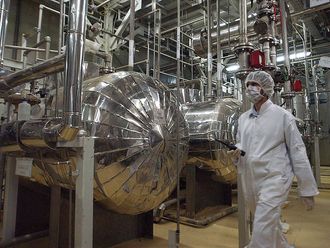Palmyra, the ancient Syrian city that has fallen to Daesh, has withstood the last 2,000 years with its immaculate temples and colonnaded streets.
‘Pearl’ of the desert’
Listed as a Unesco World Heritage site, the “pearl of the desert” is a well-preserved oasis 210 kilometres northeast of Damascus. Palmyra, which means City of Palms, is known in Syria as Tadmor, or City of Dates.
Ancient history
Its name first appeared on a tablet in the 19th century BC as a stopping point for caravans travelling on the Silk Road and between the Gulf and the Mediterranean. But it was during the Roman Empire — beginning in the first century BC and lasting another 400 years — that Palmyra rose to prominence.
Trading route
Though surrounded by desert dunes, Palmyra developed into a luxurious metropolis thanks to the trade of spices, perfumes, silk and ivory from the east, and statues and glasswork from Phoenicia.
Free city
In the year 129AD, Roman emperor Hadrian declared Palmyra a “free city” within his empire. During the rest of the century, its famous temples — including the Agora and the temple honouring Baal — were built.
Babylon gods
Before the arrival of Christianity in the second century, Palmyra worshipped the trinity of the Babylonian god Baal, as well Yarhibol (the sun) and Aglibol (the moon). As the Roman Empire faced internal political instability in the third century, Palmyra took the opportunity to declare its independence.
Zenobia’s reign
Palmyrans beat back the Romans in the west and Persian forces in the east in a revolt led by Zenobia, who then became queen.
By 270, Zenobia had conquered all of Syria and parts of Egypt, and had arrived at Asia Minor’s doorstep. But when Roman emperor Aurelian retook the city, the powerful queen was taken back to Rome and Palmyra began to decline in prominence.
Tourist site
Before Syria’s crisis began in March 2011, more than 150,000 tourists visited Palmyra every year, admiring its beautiful statues, over 1,000 columns, and formidable necropolis of over 500 tombs. Palmyra’s richest residents had constructed and sumptuously decorated these monuments to the dead, some of which have been recently looted.
Scars of war
Palmyra bears scars of Syria’s ongoing war: clashes between armed rebels and government forces in 2013 left collapsed columns and statues in their wake. According to the governor of Homs province, the inner city is home to about 35,000 people, including those displaced by fighting nearby. Another 35,000 live in the city’s suburbs.
Saving some artefacts
Hundreds of statues and artefacts from Palmyra’s museum were transferred out of the city before it fell to Daesh, according to Syria’s antiquities chief Mamoun Abdul Karim.
But many others — including massive tombs — could not be moved.











